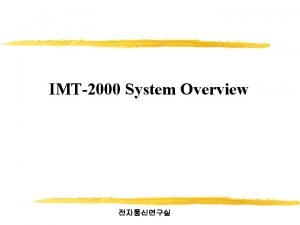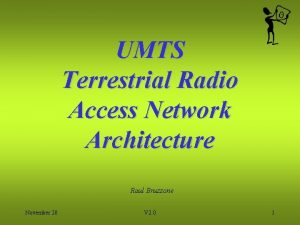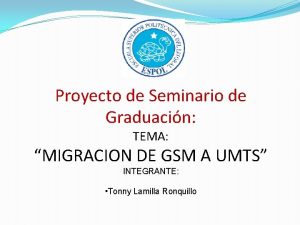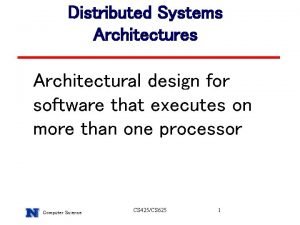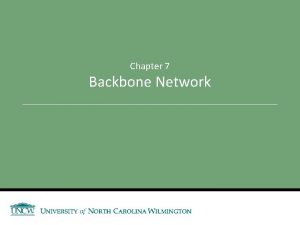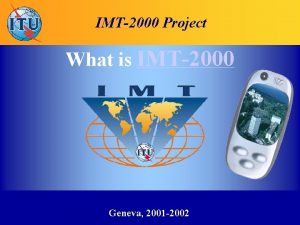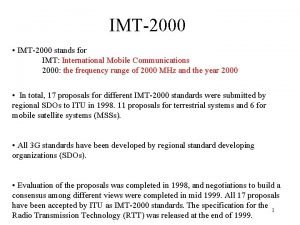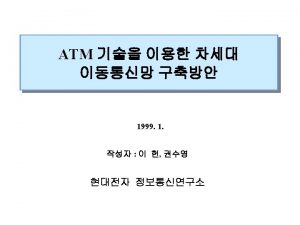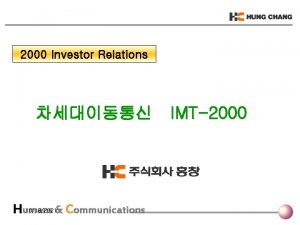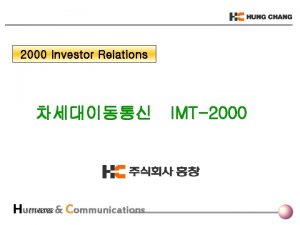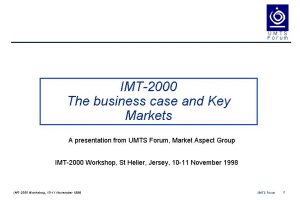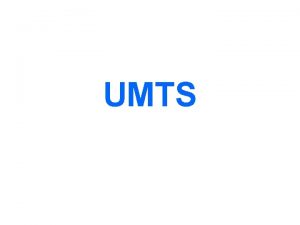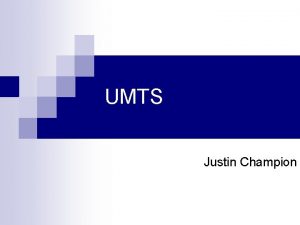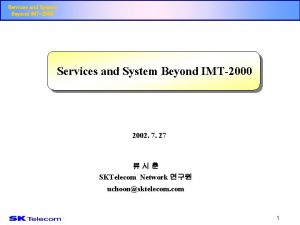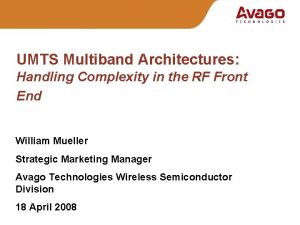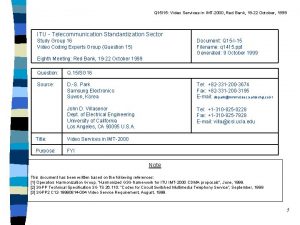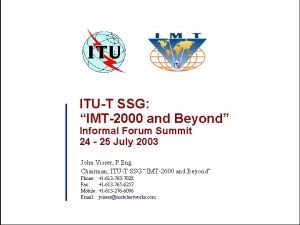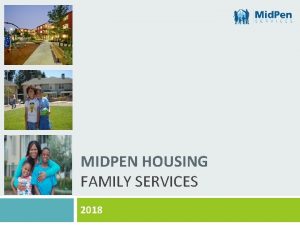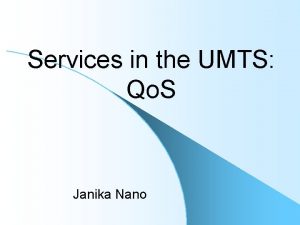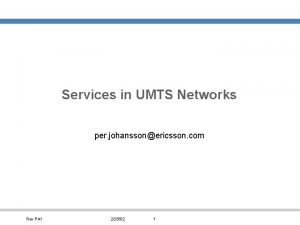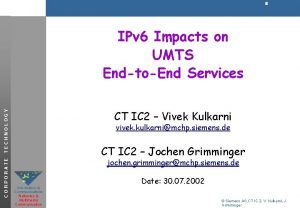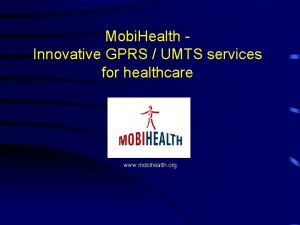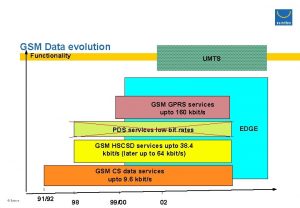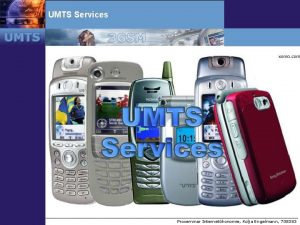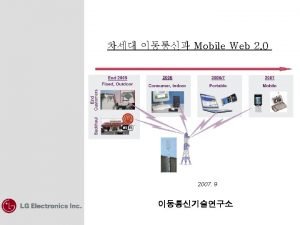Architectures and Services for the UMTS IMT2000 family











































- Slides: 43

Architectures and Services for the UMTS IMT-2000 family member Wei Lin wlin@site. uottawa. ca Mingdi Zhao rogermzhao@hotmail. com CSI 5171 Network Architectures, Services, Protocols and Standards Professor: Dr. Luigi Logrippo Dept. of Computer Science 3/21/2002 1

Contents n Overview n Architectures for UMTS system n Services of UMTS system n References 3/21/2002 2

History of Mobile Communications o First Generation: is Analog Cellular. the most prominent systems: Advanced Mobile Phone System (AMPS). Nordic Mobile Telephone (NMT), and Total Access Communication System (TACS). o Second Generation: is Multiple Digital Systems. which includes Global System for Mobile Communications (GSM), Digital AMPS (D-AMPS), Personal Communication Services(PCS), and Japanese standard Personal Digital Communication (PDC). o Third generation: extend the services provided by current second generation systems to offer high data rates services. such as multimedia telephone, video conference, video games, 3/21/2002 and provide universal coverage and enable terminals to be able 3

IMT-2000: a global standard for third generation systems, is defined by the International Telecommunication Union(ITU) The main objectives for IMT-2000 are: high data rates: 144 Kbps/384 Kbps for high mobility users with full coverage; 2 Mbps for low mobility users with limited coverage. n capability for multimedia application and all mobile applications. n high spectrum efficiency compared to existing systems n high flexibility to introduce new services n high degree of commonality of design worldwide n use of a small pocket terminal with seamless global roaming. n 3/21/2002 4

UMTS system UMTS: The most important IMT– 2000 proposal n is a 3 G GSM successor standard; n is being developed by 3 GPP, a joint venture of several SDOs: ETSI (Europe), ARIB/TTC (Japan), ANSI T-1 (USA), TTA (South Korea), and CWTS (China); n incorporates enhanced GSM Phase 2+ CNs with GPRS and CAMEL. n In UMTS, a new radio access network UMTS terrestrial radio access network (UTRAN) is introduced, which will support PS data and CS data. n Handover between UMTS and GSM is supported, and handover between UMTS and other 3 G systems will be supported to achieve true worldwide access. 3/21/2002 5

UMTS Architectures the basic domains in UMTS (copy from CWTS. org) 3/21/2002 6

UMTS Architectures (cont. ) Domain split: n User Equipment Domain: user equipment is a device allowing a user access to UMTS network services; it has a radio interface to the infrastructure. n Infrastructure Domain: the infrastructure consists of the physical nodes which perform the various functions required to terminate the radio interface and to support the telecommunication services requirements of the users. 3/21/2002 7

User Equipment Domain The user equipment is further sub-divided into: n Mobile Equipment Domain (ME) n Mobile Termination(MT) performs the radio transmission & related functions n Terminal Equipment(TE) contains the end-to-end application n User Services Identity Module Domain (USIM) contains data and procedures which unambiguously and securely identify itself. (copy from CWTS. org) 3/21/2002 8

Infrastructure Domain The Infrastructure domain is further split into: n Access Network Domain is the system of base station equipments (transceivers, controllers, etc. . . ) which manage the resources of the AN and provides the user with a mechanism to access the CN domain. n Core Network Domain consists of the physical entities which provide support for the network features & telecommunication services. n the support provided includes functionality such as the management of user location information, control of network features and services, the transfer (switching and transmission) mechanisms for signalling and for user generated information. n the core network domain may result from evolutions of existing network infrastructures, e. g. , a GSM 3/21/2002 9 infrastructure, a N-ISDN infrastructure, a B-ISDN n

Access Network Two different types of access network are used: n Base Station System (BSS) for GSM: is viewed by the MSC through a single A-interface as being the entity responsible for communicating with Mobile Stations in a certain area. Similarly, in PLMNs supporting GPRS, the BSS is viewed by the SGSN through a single Gb interface. It offers a TDMA based technology to access the Mobile Station. n Radio Network System (RNS) for UMTS: is viewed by the MSC through a single Iu-interface as being the entity responsible for communicating with Mobile Stations in a certain area. Similarly, in PLMNs supporting GPRS, the RNS is viewed by the SGSN through a single Iu-PS interface. It offers a W-CDMA based technology to access the Mobile Station. 3/21/2002 10

Core Network Domain (1) The core network domain is sub-divided into: n Serving Network Domain: represents the core network functions that are local to the user’s access point and thus their location changes when the user moves. The serving network domain is responsible for routing calls and transport user data/information from source to destination. It has the ability to interact with the home domain to cater for user specific data/services and with the transit domain for non user specific data/services purposes n Home Network Domain: represents the core network functions that are conducted at a permanent location regardless of the location of the user’s access point. The USIM is related by subscription to the home network domain. The home network domain therefore contains at least permanently user specific data and is responsible for management of subscription information. It may also handle home specific services, potentially not offered by the serving network domain. n Transit Network Domain: located on the communication path 11 3/21/2002 between the serving network domain and the remote party.

Core Network Domain (2. 1) In another logical point of view, the CN encompasses: n Circuit Switched (CS) service domain, earlier named PSTN/ISDN domain, refers to the set of all the CN entities offering "CS type of connection" for user traffic as well as all the entities supporting the related signalling. A "CS type of connection" is a connection for which dedicated network resources are allocated at the connection establishment and released at the connection release. The entities specific to the CS domain are: MSC, GMSC. n Packet Switched (PS) service domain, earlier named IP domain, refers to the set of all the CN entities offering "PS type of connection" for user traffic as well as all the entities supporting the related signalling. A "PS type of connection" transports the user information using autonomous concatenation of bits called packets: each packet can be routed independently from the previous one. The entities specific to the PS domain are the GPRS specific entities, i. e. SGSN and GGSN. 3/21/2002 12

Core Network Domain (2. 2) CN AN the separate CN architecture case (copy from CWTS. org) 3/21/2002 13

Core Network Domain (2. 3) the integrated CN architecture case (copy from CWTS. org) 3/21/2002 14

Core Network Domain (2. 4) n UE, that is supporting both CS services and PS services, The two peers of the service state machine are working independently to each other (synchronization). n A single RRC connection (between UTRAN and UE) shall carry all user plane and signalling flows to/from a UE. n The aim of UTRAN is to offer one unified set of radio bearers which may be used for burst packet traffic and for traditional telephony traffic. n For the mobility functionality, four different area concepts are used. Location Areas and Routing Areas are used in the Core Network. UTRAN Registration Areas and Cell Areas are used in UTRAN. Location Areas are related to CS services. 15 3/21/2002 Routing Areas are related to PS services.

Core Network Domain (2. 5) n In the separate CN architecture case, the CN consists of both a CS service domain with evolved MSC/VLR, 3 G_MSC/VLR, as the main serving node and an PS service domain with evolved SGSN/GGSN, 3 G_SGSN and 3 G GGSN, as the main serving nodes. n In the integrated CN architecture case, the CN consists of both a CS service domain and an PS service domain with an UMSC as the main serving node. n The use of separated PS and CS mobility mechanisms within the UE and within the CN may lead to non-optimal usage of the radio resource 3/21/2002 16

PLMN n The public land mobile network (PLMN) described in UMTS Rel. ’ 99 incorporates three major categories of network elements: GSM Phase 1/2 core network elements: mobile services switching center (MSC), visitor location register (VLR), home location register (HLR), authentication center (AC), and equipment identity register (EIR) • GSM Phase 2+ enhancements: GPRS (serving GPRS support node [SGSN] and gateway GPRS support node [GGSN]) and CAMEL (CAMEL service environment [CSE]) • UMTS specific modifications and enhancements, particularly UTRAN • 3/21/2002 n may be regarded as an extension of a network (e. g. 17

Basic configuration of a PLMN (1) bold lines show interfaces supporting user traffic; dashed lines show interfaces supporting signalling. 3/21/2002 (copy from CWTS. org) 18

Basic configuration of a PLMN (2) n The figure presents the basic configuration of a Public Land Mobile Network (PLMN) supporting GPRS and the interconnection to the PSTN/ISDN and PDN. n The figure shows direct interconnections between the entities. The actual links may be provided by an underlying network (e. g. SS 7 or IP): this needs further studies. n The most important evolutionary step of GSM toward UMTS is GPRS introduces PS into the GSM CN and allows direct access to packet data networks (PDNs). GPRS prepares and optimizes the CN for high–data rate PS transmission, as does UMTS with UTRAN over the RAN. n Two functional units extend the GSM NSS architecture for GPRS PS services: the GGSN and the SGSN. The GGSN has functions comparable to a gateway MSC (GMSC). The SGSN resides at the same hierarchical level as a visited-MSC /VLR and therefore performs comparable functions such as routing and mobility management. n The MSC provides functions such as switching, signaling, 3/21/2002 19 paging, and inter–MSC handover.

Basic configuration of a PLMN (3) n Existing network elements, such as MSC, and HLR, can be extended to adopt the UMTS requirements. n But RNC, Node B, and the handsets must be completely new designs: RNC will become the replacement for BSC, and Node B fulfills nearly the same functionality as BTS. n GSM and GPRS networks will be extended, and new services will be integrated into an overall network. UMTS defines four new interfaces: Uu: UE to Node B, the UMTS W–CDMA air interface • Iu: RNC to GSM Phase 2+ CN interface (MSC/VLR or SGSN) o Iu-CS for circuit-switched data o Iu-PS for packet-switched data • Iub: RNC to Node B interface • Iur: RNC to RNC interface, not comparable to any interface in GSM 3/21/2002 20 n The Iu, Iub, and Iur interfaces are based on ATM •

Basic configuration of a PLMN (4) (copy from iec. org) 3/21/2002 21

Basic Configuration with GLR (1) n The Gateway Location Register (GLR) handles location management of roaming subscriber in visited network without involving HLR. n The benefit of the GLR is the reduction in signalling traffic between networks. n This entity can be only located in a visited PLMN. (copy from CWTS. org) 3/21/2002 22

Basic Configuration with GLR (2) n In above figure, the GLR interacts with HLRa and VLRb for roamers on Network B. The GLR is part of the roaming subscriber's Home Environment. n When a subscriber to HLRa is roaming on Network B the GLR plays the role of an HLR towards VLRb and the role of a VLR towards HLRa. The GLR handles any location change between different VLR service areas in the visited network without involving HLRa. n The sequence of events when the subscriber roams to network B is: n VLRb sends the registration message to HLRa via the GLR, (i. e. HLRa stores the GLR's SCCP address and the GLR stores VLRb's SCCP address); n HLRa returns the subscriber profile data; n the subscriber profile is stored in the GLR and VLRb. n As the roaming subscriber moves between VLRs in network B, 3/21/2002 23 then the GLR is updated, but no message is sent to HLRa,

Service Aspects of IMT 2000 n Services structure in PLMNs n Services principles for PLMNs n Categories of services n Supplementary services (11) n Line identification n Advice of Charging n Other services 3/21/2002 24

The Service Structure in PLMNs 3/21/2002 (copy from CWTS. org) 25

Service principles for PLMNs Ø to provide a single integrated system in which the user can access services in an easy to use and uniform way in all environments. Ø to provide a wide range of telecommunications services. Ø to provide support of roaming users by enabling users to access services provided by their home environment in the same way even when roaming. Ø to provide audio, data, video and particularly multimedia services; 3/21/2002 26

Categories of telecommunication services BEARER SERVICE TELESERVICE n. Basic Bearer Service n. Basic Teleservice n. Basic Bearer service n. Basic Teleservice + +supplementary services supplementary service 3/21/2002 27

Supplementary services Supported by PLMNs (1) n Line identification Supplementary Services CLIP --- Calling line identification presentation. n CLIR --- Calling line identification restriction. n COLP --- Connected line identification presentation. n COLR --- Connected line identification restriction. n 3/21/2002 28

CLIP Process (1) Idle Initial handling of CLIP Provisioned Yes no set provision Indication =not provisioned set provision Indication=provisioned Called subscriber in HPLMN country no yes Override category no yes set override Category=No Continue call handling idle 3/21/2002 CLIP—Calling line Identification Presentation Determination of calling line identification presentation subscription(VLR) (copy from CWTS. org) 29

CLIP Process (2) no CLIP provisioned yes no CLI available Idle yes Initiate handling Of CLIP yes CLI received from VLR Use CLI received from VLR no use CLI received from signaling PI = presentation restricted? Yes no Cause of no CLI override category yes Additional CLI available No no no Additional CLI available yes PI = presentation restricted by network? Yes override category CLI in case of override category yes No CLI Yes set PI = Presentation restricted Additional CLI Pass Additional CLI pass CLI Set PI = number not available pass CLI pass Additional CLI set PI = number not available Continue Call handling idle CLIP: Calling Line Identification Presentation. CLI: Calling Line Identity. PI: Presentation Indicator. Determination of the information for offering to the called party (destination MSC) 3/21/2002 30 (copy from CWTS. org)

CLIR Process (1) idle Initiate handling Of CLIR provisioned no yes set provision indication = not provisioned set provision Indication=provisioned subscription option = permanent yes no temporary mode default =present restricted no yes mode indication = temporary (pres. restricted) mode indication = temporary (pres. allowed) set mode indication = permanent continue Call handling CLIR: Calling Line Identification Restriction idle Determination of calling line identification restriction subscription 3/21/2002 31 (copy from(VLR) CWTS. org)

CLIR Process (2) idle Initiate handling Of CLIR no yes CLIR provisioned yes restrict CLI note 2 no permanent no yes temporary mode default = pres. restricted present CLI note 1 no Clear call no yes Error notification present CLI note 1 no yes no restrict CLI note 2 yes Set PI= Presentation allowed set PI = presentation restricted Continue call handling idle Set PI= Presentation allowed Set PI= Presentation restricted note 1: present CLI is input received from the MS note 2: restrict CLI is input received from the MS CLIR: Calling Line Identification Restriction CLI: Calling Line Identity PI: Presentation Indicator Determination of the presentation indicator (originating MSC) 3/21/2002 (copy from CWTS. org) 32

COLP Process idle Initiate handling Of COLP provisioned no yes COL available no yes Override category no Presentation restricted yes no Additional COL available no additional COL available yes no yes COL in case of override category Additional COL Pass additional COL pass COL Continue COL handling Pass additional COL set PI = Number not available COLP: Connected Line Identification Presentation. COL: Connected Line Identity. PI: Presentation Indicator. idle Determination of the information for offering to the connected party (originating MSC) 3/21/2002 (copy from CWTS. org) 33

COLR Process idle initiate handling of COLR provisioned no yes set PI = presentation restricted continue call handling set PI = presentation allowed COLR: Connected Line Identification Restriction. PI: Presentation Indicator. idle Determination of the presentation indicator 3/21/2002 (copy from CWTS. org) 34

Supplementary services Supported by PLMNs (2) n Call Forwarding (CF) supplementary services 3/21/2002 (copy from CWTS. org) 35

Supplementary services Supported by PLMNs (3 -10) 3. Follow Me service 4. Call Waiting (CW) and Call Holding (HOLD) Supplementary Services 5. Multi. Party (MPTY) Supplementary Services 6. Closed User Group (CUG) Supplementary Services 7. User-to-User Signalling (UUS) 8. Call Barring (CB) Supplementary Services 9. Explicit Call Transfer (ECT)--Supplementary Service 10. Unstructured Supplementary Service Data (USSD) 3/21/2002 36

Supplementary services Supported by PLMNs (11) n Advice of Charge (Ao. C) Supplementary Services (information) call in progress or Call set up in progress request generation of CAI Request of generation of CAI applies to Ao. C initiation or charge modification. generate CAI send CAI continue call Or call set up CAI: Charge Advice Information SDL diagram of advice of charge (information) in the MSC 3/21/2002 (copy from CWTS. org) 37

Supplementary services Supported by PLMNs (11) n Advice of Charge (Ao. C) Supplementary Services (information) call set up In progress charging information Ao. C active call ends Start charge calculations Ao. C acknowledge Ao. C active charging information Ao. C acknowledge Stop charge calculations Amend charging calculation clear call Ao. C active Point at which charging calculations are amended can occur before or after sending the Ao. C acknowledge. SDL diagram of advice of charge (information) in the Mobile Equipment 3/21/2002 (copy from CWTS. org) 38

Supplementary services Supported by PLMNs (11) n Advice of Charge (Ao. C) Supplementary Services (charging) call in progress or Call set up in progress request generation of CAI generate CAI send CAI wait for Ao. C acknowledge Request of generation of CAI applies to Ao. C initiation or charge modification. Ao. C acknowledge Timer T(Ao. C) expired stop timer T(Aoc) Clear call in progress idle Call cleared stop timer T(Ao. C) start timer T(Ao. C) CAI: Charge Advice Information wait for Ao. C acknowledge SDL diagram of advice of charge (charging) in the Mobile Equipment 3/21/2002 (copy from CWTS. org) 39

Supplementary services Supported by PLMNs (11) Advice of Charge (Ao. C) Supplementary Services (chageing) • This service provides the means by which the MS may indicate the charge that will be made for the use of telecommunication services. It is intended for applications where the user is generally not the subscriber but is known to the subscriber, and where the user pays the subscriber, rather than the Service Provider. • When required to indicate the total accumulated charge, the MS shall be able to display, and the SIM/USIM shall store in the ACM, the running cumulative unit charge. This value must be stored securely, and all reasonable steps shall be taken to ensure that the written value cannot be interrupted, reset or corrupted (except resetting under 40 3/21/2002

Other services supported by PLMNs(1) n International Mobile Station Equipment Identity (IMEI) n Personalization of Mobile Equipment (ME) n Man-Machine Interface (MMI) of the User Equipment (UE) n High Speed Circuit Switched Data (HSCSD) n USIM/SIM Application Toolkit (USAT/SAT) n Operator Determined Barring (ODB) n Network Identity and Time zone (NITZ) n Support of Localised Service Area (So. LSA) n Mobile Station Application Execution 3/21/2002 Environment (MEx. E) 41

Other services supported by PLMNs(2) n General Packet Radio Service (GPRS) n Support of Mobile Number Portability (MNP) n enhanced Multi‑Level Precedence and n n n Pre‑emption service (e. MLPP) Location Services (LCS) Call Deflection (CD) Customised Applications for Mobile network Enhanced Logic(CAMEL) Completion of Calls to Busy Subscriber (CCBS) Multiple Subscriber Profile (MSP) Multimedia Messaging Service (MMS) 3/21/2002 42

References n http: //www. cwts. org/cwts/itu. htm n http: //www. iec. org/online/tutorials/umts/index. html 3/21/2002 43
 Cdma 2000 architecture
Cdma 2000 architecture Umts terrestrial radio access
Umts terrestrial radio access Arquitectura umts
Arquitectura umts Database and storage architectures
Database and storage architectures Autoencoders, unsupervised learning, and deep architectures
Autoencoders, unsupervised learning, and deep architectures Integral product architecture
Integral product architecture Ansi sparc
Ansi sparc Backbone network architectures
Backbone network architectures Scalable internet architectures
Scalable internet architectures Modular product architectures
Modular product architectures Gui architectures
Gui architectures Database system architectures
Database system architectures Cdn architectures
Cdn architectures Aaron bannert
Aaron bannert 4 tier architecture of data warehouse
4 tier architecture of data warehouse Isa architecture
Isa architecture Client server model in e commerce
Client server model in e commerce Distributed systems architectures
Distributed systems architectures Backbone network architectures
Backbone network architectures Gpu cache coherence
Gpu cache coherence Why systolic architectures
Why systolic architectures Conjugal family
Conjugal family Fspos vägledning för kontinuitetshantering
Fspos vägledning för kontinuitetshantering Typiska novell drag
Typiska novell drag Nationell inriktning för artificiell intelligens
Nationell inriktning för artificiell intelligens Returpilarna
Returpilarna Shingelfrisyren
Shingelfrisyren En lathund för arbete med kontinuitetshantering
En lathund för arbete med kontinuitetshantering Kassaregister ideell förening
Kassaregister ideell förening Vilotidsbok
Vilotidsbok Anatomi organ reproduksi
Anatomi organ reproduksi Vad är densitet
Vad är densitet Datorkunskap för nybörjare
Datorkunskap för nybörjare Stig kerman
Stig kerman Mall för debattartikel
Mall för debattartikel Autokratiskt ledarskap
Autokratiskt ledarskap Nyckelkompetenser för livslångt lärande
Nyckelkompetenser för livslångt lärande Påbyggnader för flakfordon
Påbyggnader för flakfordon Formel för lufttryck
Formel för lufttryck Offentlig förvaltning
Offentlig förvaltning Jag har nigit för nymånens skära text
Jag har nigit för nymånens skära text Presentera för publik crossboss
Presentera för publik crossboss Vad är ett minoritetsspråk
Vad är ett minoritetsspråk Kanaans land
Kanaans land
